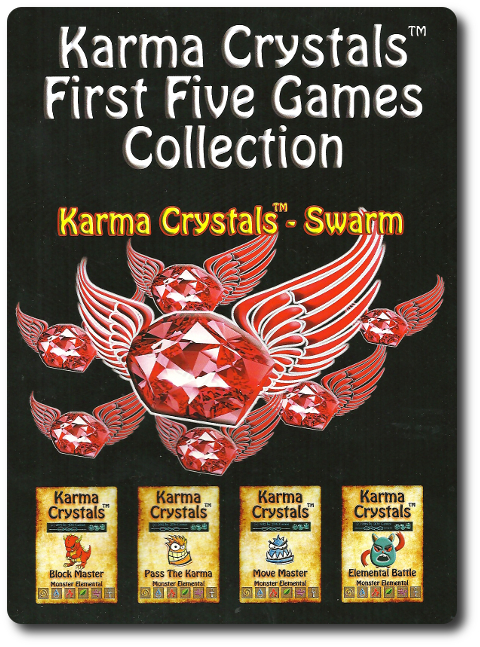
The Basics:
- For ages 8 and up (publisher suggests 12+)
- For 1 or more players
- Variable game play length
Geek Skills:
- Counting & Math
- Logical & Critical Decision Making
- Pattern/Color Matching
- Strategy & Tactics
- Risk vs. Reward
- Cooperative & Team Play
- Hand/Resource Management
- Worker Placement & Area Control
Learning Curve:
- Child – Easy
- Adult – Easy
Theme & Narrative:
- A box of games to play and improve upon
Endorsements:
- Gamer Geek rejected!
- Parent Geek mixed!
- Child Geek approved!
Overview
American actor, screenwriter and film director, Sylvester Stallone, said “There’s a natural law of karma that vindictive people, who go out of their way to hurt others, will end up broke and alone.” Clearly Mr. Stallone has never played a cutthroat game of Monopoly. Regardless, there is truth in his statement. In this series of games, what you do to others might comeback to haunt you or lead to victory. Karma is funny that way.
Karma Crystals: First Five Games, designed by Teo Graca and published by 3D6 Games via the Game Crafter, is comprised of 288 square shards, 72 tombstone shards, 8 Player stands, 2 gems, 50 red Karma Crystals (also referred to as “KC”), 5 extra plastic baggies (to hold components), 18 Monster Elemental cards, 18 Elemental Dice cards, 12 square 4×4 grid cards, and 12 jumbo cards (that contain instructions to games and are used as a game component). The cards are as thick and as durable as your standard playing card. The illustrations are fairly minimal, with the most interesting artwork focused on the various little elemental creatures that are part of the game. The most disappointing component of the game are the shards, which feel slightly less thick than a playing card, but only slightly thicker than a piece of heavy paper.
One Box, Five Games
Karma Crystals: First Five Games is a collection of games that use many of the same components, but have very different rules. As such, the game box contains everything necessary to play any of the games, but not all of the components will be used during each game playing session. Furthermore, the game components have just enough detail to play well to each of the 5 games themes, but are still universally ambiguous enough to effortless transition from one role to another per game.
Indeed, one of the collection’s goals, other than to combine the preconstructed games into one offering, is to provide the players game components to create their own games to enjoy. This makes Karma Crystals: First Five Games not only a collection of games, but a toolbox that invites players to use their creativity to design their own games that can be played and shared. A deft stroke, as it makes the offering all the more enticing, opening the door of limitless opportunity.
Introducing the Bits
It’s easiest to summarize the whole by first summarizing the components. The majority of the components play multiple roles, making each a much more important aspect of the overall game play. Each of the game bits are summarized here that are not specific to any one particular game.
The Markers
Several markers are provided. The most used is the First Turn marker, which is an orange glass gem. It’s used to identify which player is the first player or who currently holds that role. It’s also used to help keep track of when a round begins and ends. Accompanying the First Turn marker is the Current Turn marker. This is a white glass gem and easily identified when next to its companion marker. This marker’s main purpose is to allow players to pause the game and use the Current Turn marker to indicate which player will take their turn when the game resumes.
The Shards
Up to 8 players can enjoy a single game per the current games provided, but if there are fewer, auto-players can be included. A total of 9 Player shards are provided, but only 8 will ever be used. If the players like, they can include any number of auto-players as long as the total of all players (real and unreal) is no more than 8. Auto-players virtually sit between real players during the game. If an auto-player sits to the left of a player, that player makes all the choices for that auto-player. If there is more than one auto-player to the player’s left, they make choices for that auto-player, as well, until the next player in the turn order sequence is a real player.
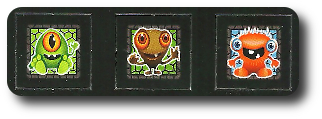
Additional shards include those that will be used to represent the 6 different types of elements (Creativity, Water, Fire, Leaf/Earth, Wind/Air, and Spirit/Ankh), track movements, track blocking, track victories, and standing in for Karma Crystals.
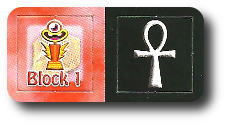
The Dice Cards
Instead of being limited by the roll of a die, the game designer instead decided to provide a deck of Dice cards. These have the values 1 through 6 and are meant to be drawn at random when a die roll value would otherwise be called for. If this was their only purpose, I would question their use. However, each card also depicts one of the elemental types used in the game, giving each card a dual purpose. In addition, one of the goals of Karma Crystals: First Five Games, was to provide the players a means to create their own games. I can see the Dice cards playing pivotal roles in some game designs, or being used as a fancy way to randomize less important outcomes.
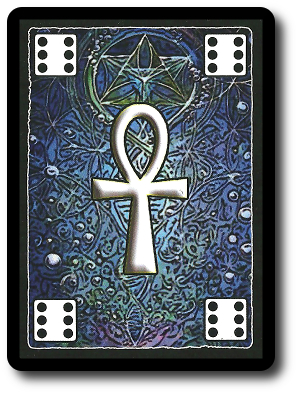
The Monster Elemental Cards
The Monster cards depict an illustration of a cute little monster, its name (which is an alphanumeric categorization value), and a short inspirational quote. While all very charming, the most important aspect of the card is the Move Match guide noted at the top. This matches the number of moves allowed to specific elemental icons. Even more interesting, not every elemental monster moves the same. Some are slower and some are faster.
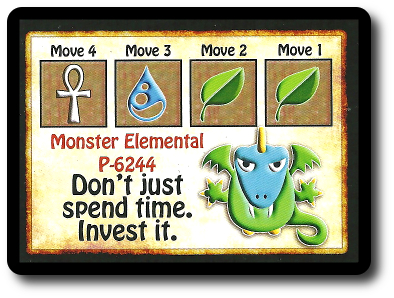
The Grid Cards
The grid cards are used to create a playing surface where the players will be moving their shards in an attempt to capture certain positions and items that are placed on it. The grid cards are double-sided, with one side featuring just a plain 4×4 playing area and the other featuring the same space, but with elemental symbols and other helpful icons.
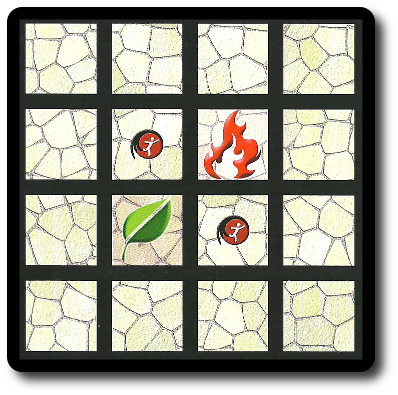
The Jumbo Cards
These cards have 2 different roles. The first is to teach the player the game. The introduction to the game components, general game set up, and specific game rules are documented on the jumbo cards. On the other side of the cards is a playing card for the Block Master game that is included.
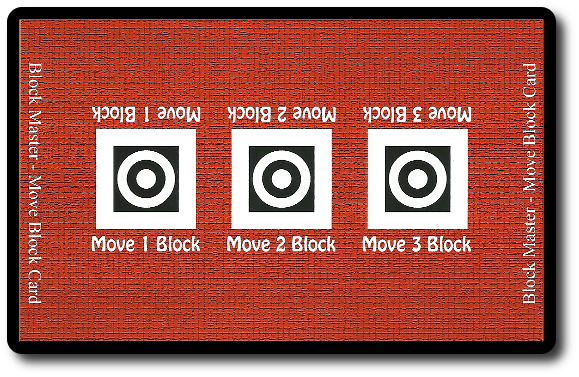
The Games
Having now gone over the game components, it’s time to summarize the games that come ready to play right out of the box.
Block Master
This game makes use of the Game Win shards and Move Block jumbo cards. Give each player a Move Block card, which is placed in front of them. The Block shards (which are the opposite of the Move shards) are collected and put into a single pile next to another pile that contains the Move shards. These are a shared supply for all players. Before starting, make sure each player has a Player shard and Monster Elemental card.
On a players turn, they lightly shuffle the Dice cards and draw 3, placing them face-up. If the Dice cards do not match with the player’s Elemental Monster card, this is referred to as a “No Match”. At which time, the player places their Player token on an opponent’s Move Block card on the “1”, “2”, or “3” move value, which blocks that score value. This game is all about “tit for tat”, and a player might quickly learn that too much negative focus on one opponent will be returned in kind, if not double-so. The goal is to evenly distribute the negativity, while at the same time moving towards a victory.
Pass the Karma
This game challenges players to scores Elemental shards by matching 1 or more matches with the Dice cards and Elemental Monster cards. By collecting 2 or more of any Elemental shard type, the extras can be returned to the supply. For each returned, 1 point is earned, but more are earned the higher the more matches they make. Not matching gives the player a red crystal that can later be passed to an opponent if the player is unable to make another match. The passed red crystal goes into an opponent’s scoring area. When the game ends, players count their points, but are penalized for the red crystals they have in their scoring area.
Move Master
The object of this game is to score the most Move and Elemental shards, while at the same time avoiding collecting the Counter shards. This game is somewhat the reverse of the Pass the Karma, but the penalty is given when players collect more than 1 Element shard of any type. When they do, they must return it to the supply and collect 1 Counter shard for each 1 Element shard returned. Further more, not matching anything will penalize the player, as well. The first player to score 11 Move shards ends the game, but the player with the most points wins. Points are determined by taking the total number of Move shards and subtracting that value by the total number of Counter shards.
Elemental Battle
This game is more confrontational than the previously mentioned games, although one could easily argue there is an obvious passive aggressive element in the game play. Not the case here. The aggression is anything but passive as players battle using the elements. Elemental and Counter shards are organized into their own supply piles. If the player gets a Karma elemental move match, this allows for scoring up to 3 elemental battles. The Elemental shards are used for the battles (and scoring), with each player able to control 9 Elemental shards at a time.
Battles are more or less a slightly more complicated version of Rock-Paper-Sissors, but players can also capture (sacrifice 1 Elemental shard to capture an opponent’s Elemental shards of a single type), recruit (similar to capture, but it takes 2 matching Elemental shards), and transfer (with takes 3 Elemental shards, but pulls the shards collected by opponents).
The game ends when any player has scored 11 or more points. The winner is the player with the most points after adding up all the Elemental shards and subtracting that total from the total number Counter shards.
Swarm
A common theme in the game is Elemental shards being trumped by Counter shards. In this game, both Elemental and Counter shards are of value. The 12 4×4 Grid cards are used and represent something like an arena. Each player will given 3 Move shards which are used to represent the number of actions the player has. On a player’s turn, they place an unused Grid card and place a red crystal on it. Then the player determines how many Move shards are collected. The player can now take actions.
- Attack another player
- Capture a red crystal
- Move the player’s token or a red crystal
- Place a red crystal on any unoccupied space
The game continues until a player scores 1 of each Elemental type and 3 or more red crystals. The winner is the player who has collected the most Elemental and Counter shards in their scoring area.
Beyond the Box
The five games provided demonstrate how easy it is to use very little to create a game that challenges a player to think tactically and logically. Admittedly, my summaries of each do not go into enough detail to easily determine the game’s level of difficulty or depth, but it should be clear that there are multiple levels of game play. In fact, I would be hard pressed to say that any of the game’s are “easy”, as each requires the players to sit up and pay attention if they are to remain competitive.
But the games do not have to end, nor should the players feel limited by the rules provided. One of the goals of the offering was to provide a means for players to create their own games. I can think of no better way to build a new game than using the solid foundation already set by the designer. Alter the rules, add new ones, and remove old ones. Tinker, adjust, modify, and expand. This is all possible and allowed. There are no limitations, nor should players feel restricted.
To learn more about Karma Crystals: First Five Games, visit the game’s web page.
Final Word
The Child Geeks were pretty excited when I told them we would be playing a small box full of no less than 5 games. After playing all of them a few times, each player had their favorite, but none of the Child Geeks felt like they enjoyed all the games. According to one Child Geek, “I think of it like a buffet. I don’t have to like them all to still enjoy it.” Very true. Another Child Geek said,”I liked Swarm the best and Move Master the least. All the rest where OK.” When I told the Child Geeks they were welcome to make their own games using the game components, some jumped at the opportunity and others said they had no interest. The Child Geeks who did want to make their own games used the existing games as templates and improved upon them as they felt best. Which was a lot of fun, especially when we were able to play the Child Geek games. When the all the games were done and the last component put away, the Child Geeks approved the game and game system.
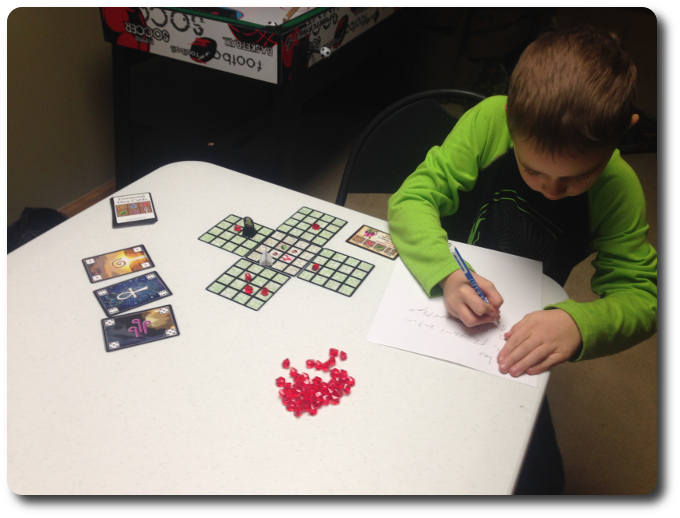
A Child Geek tries his hand at becoming the next Reiner Knizia…
The Parent Geeks felt that the games were short, to the point, and had just enough depth to keep them interested, but not all the games were enjoyed. This paralleled the Child Geek’s observations, as well. The Parent Geeks liked some of the games, but never all of them. Furthermore, every game that came in the box had at least 1 supporter. According to one Parent Geek, “I think the games do a great job of showcasing all the things you can do, but it never really felt like I was playing a complete game.” This was a common statement from the Parent Geeks who felt that they were missing something or the games should be more. In truth, what they played was complete and the Parent Geeks recognized that, but that did not stop them from wanting the games to be more complex. The game system aspect didn’t interest any of the Parent Geeks, but they did like the idea that they could make games with their children. In the end, the Parent Geeks gave Karma Crystals a mixed level of approval.
The Gamer Geeks thought the idea of providing a game system to be intriguing, but found the games provided to be little more than demonstrations. That is, not fully developed games. According to one Gamer Geek, “Each game in the box is built on the same base and feels a lot alike, to a point where I don’t think I’m doing much other than playing a slightly different game with slightly different parts.” Another Gamer Geek said, “The games included do a great job of demonstrating what can be done with the game components and imagination, but the games are not that interesting.” Oddly enough, the Gamer Geeks fully recognized the fact that Karma Crystals was meant to be used as a game system, but because that use was a secondary aspect of the offering, they judged it fully on the games. As such, the Gamer Geeks rejected Karma Crystals, finding the games to be lacking the kind of depth and strategy they hunger for.
I found it very interesting that our players observed the games as demonstrations and working examples of what could be done with the game components, rather than fully developed games in and of themselves. The games that are included are complete, start to finish. Each game component is used, but at no time did I personally think that the game that used them was just a means to spotlight bits and pieces. Indeed, I found a number of the games to be very entertaining.
As entertaining as the games might be, I also found the process of learning how to play them to be strangely difficult. This coming from a guy who reads game manuals for fun. The games are so condensed that their already abstract nature is further compounded by the summarized game play that is separated from detailed component descriptions. This is due to the format of the game rules, which first summarizes all the components in one section and then describes game play in another. There’s enough there to put all the pieces together, but I found myself working harder to learn how to play the game than I ever thought necessary. I mention this for two reasons. First, when you read the rules, don’t feel bad about “not getting it”. You need to put everything in front of you and then read the rules. Everything will make sense. Second, new players and inexperienced players are going to have a hard time setting up, let alone teaching the games. I suggest a more experienced player or someone who has already played the games several time be the teacher.
Other than, I’m pleased with the games. They are creative, simplistic in design, yet cleverly executed so as to provide a gaming experience that is worthwhile. Some of the games are very abstract and that might very well turn off a number of players. I encourage everyone to stick with it, however. The game’s level of abstractness is meant to provide freedom to represent multiple ideas, while never really pinning itself down. You cannot be all things to all people, as this game clearly demonstrated, but it does try to as flexible as possible. If only falls down when instructions do not clearly communicate the game’s goals to the reader. At which point, there is nothing to be done but to read the rules again or simply make your own.
This game was given to Father Geek as a review copy. Father Geek was not paid, bribed, wined, dined, or threatened in vain hopes of influencing this review. Such is the statuesque and legendary integrity of Father Geek.




Our kids love this game too. Great review! As Parent Geeks, we have a little trouble with the shards too, but the kids don’t have any issues with them. Teo mentioned using chits and packaging it in a large box, but that it would increase the cost of the game to about $80 and shipping would be around $12, which seems too expensive. If it got picked up by a major manufacturer, it could probably be priced around half that. We’ll see if this game system goes to the next level or not. The review really spells it all out. Thanks! Best wishes from – George and Jackie! (Parent Geeks)
Thanks for taking the time to read the review and leave a comment, George and Jackie.
Keeping the price down is essential for publishers so they can maximize sales and turn a profit (or at the very least, break even). One of the ways this is done is by reducing the number of components or reducing the quality of the components. We see it all the time. Flimsy cards, thin game boards, and poorly printed details. None of this impacts the mechanics of the game, but it does influence the overall game play. A poorly designed game with excellent components is often held in higher regard than a very well designed game with poorly crafted components. Which I have always found to be strange…
In the case of Karma Cyrstals, we have a good game that is being hindered by some of its components. Fair or not, players become exasperated with the bits and take it out on the game itself. Much like how people curse the Golf ball for not sinking in the hole instead of blaming their horrible backswing. The point is, this is a very good game and if people get hung up on the components, they’ll never see that. The only way to address the issue is to add better components, which will drive the price of the game up.
Which isn’t good.
A compromise will have to be made when the designer is able to answer this question with confidence: Do players value mechanics over substance? The only way to answer that question is to know of your audience.